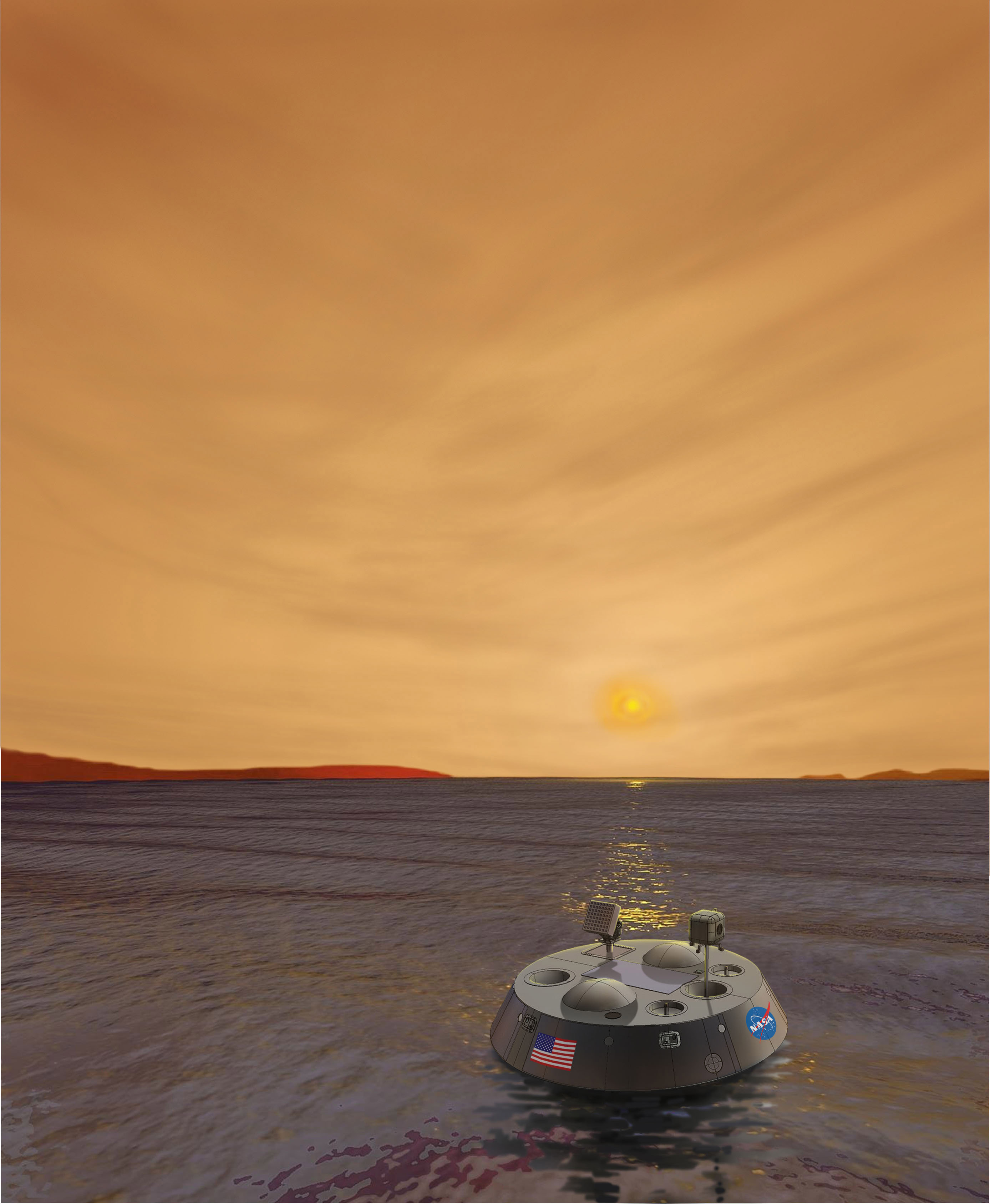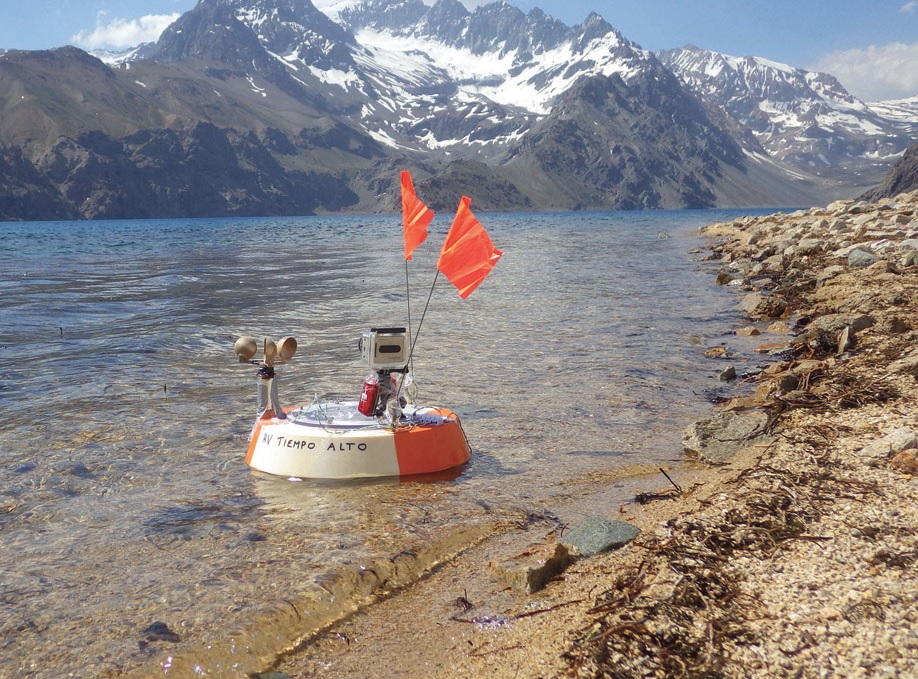Lander Designed for Titan's Methane Seas Tests Tech on Chilean Lake

A mission proposal that would send a spacecraft to land on Saturn's moon Titan and float in its methane seas was passed up by NASA, but the project isn't completely sunk.
New research describes tests done with a miniature mock-up of the lander concept, which is called the Titan Mare Explorer (TiME). The research, in which the miniature lander was set lose on a lake in Chile, shows how the probe might be affected by winds and waves on the Saturn moon. The results could prove helpful for future spacecraft that may dive into the diverse environments on other worlds in Earth's solar system.
According to TiME's former principle investigator Ellen Stofan, the trial wasn’t designed to be a complete test of TiME, but an opportunity to explore how a floating lander might behave.
"I found it extremely helpful to see the remote operations, and to participate in measuring the depth of the lake [with TiME]," Stofan told Space.com by email. "Ground experiments really help you think about how to collect and interpret space data." [Amazing Photos of Titan, Saturn's Largest Moon]
Adrift on Titan's lakes
Saturn's moon Titan is the only place in the solar system other than Earth known to have liquid lakes and seas on its surface. Rather than water, methane and ethane make up the pools, while methane rain falls on the surface. The flowing liquids could give rise to life-forms completely different from those on Earth, making Titan one of the most astrobiologically intriguing spots in the solar system, scientists have said.
In 2007, not long after the discovery of Titan's northern lakes, Stofan and her colleagues developed TiME. The spacecraft relied on a new radioisotope power source under development by NASA called the Advanced Stirling Radioisotope Generator (ASRG). The mission's budget had to be $425 million or less to qualify as one of NASA's Discovery-class missions.
"[The Jet Propulsion Laboratory] had done a study saying that nothing could be done at Titan for under a billion dollars," Stofan said. "We were going to show it could be done for less than half of that. We really had to focus on the best science and keep it simple."
Get the Space.com Newsletter
Breaking space news, the latest updates on rocket launches, skywatching events and more!
If this mission had become a reality, the probe would have splashed down in Ligeia Mare, a methane-ethane sea near Titan's north pole, in 2023, Stofan said. Unlike other landers, it would have bobbed along the surface, traveling wherever the currents and winds of Titan might carry it. As it drifted across the lake, with about 6.5 feet (2 meters) of its bulk peeking above the sea, it would have measured the temperature, atmospheric pressure, methane humidity, and the strength, direction, and distribution of winds on the moon.
"All of this would help us understand exactly how the Titan atmosphere and sea interact, see how waves are generated, and see if the chemistry of the lakes was leading toward life," Stofan said.

Lake observations in Chile
In the summer of 2013, TiME scientists paired up with another team working on the Planetary Lake Lander (PLL) project, which was partly funded by NASA and was also created to prepare spacecraft to visit Titan. A free-floating platform was set on a lake in Chile to observe how TiME's attempts to collect information about an extraterrestrial lake might be affected by the wind and waves. To better understand how the data generated by TiME or another floating lander would look, the team carried a smaller model of the craft, dubbed RV Tiempo Alto, up to Laguna Negra in the Chilean Andes, and set it adrift.
RV Tiempo Alto wasn't an exact analogue of the TiME. As part of the PLL project, its goal was to examine how a capsule would behave in known winds and waves. According to current TiME principal investigator Ralph Lorenz and PLL project leader Nathalie Cabrol, such an imaging system is novel in planetary geology, and hasn't had much use in oceanographic studies. The team launched RV Tiempo Alto onto the water four times, with a GoPro camera strapped on to record data, and two large, orange flags to aid in its recovery.
The stand-in spacecraft found that the wind drag on the hull was the primary factor in determining its path across the lake. The scientists also learned more about the signals created by light reflection off the water and breaking waves along the shoreline, as well as interactions between the hull and lake bottom — phenomena that were challenging to simulate. Their research was published in the journal Astrobiology in November 2016.
Mission timing
In 2011, TiME made NASA's short list of three proposals for NASA's next Discovery class mission, but in 2012, it lost out to the Mars InSight Lander. According to Stofan, the ASRG power source wasn't ready, and the mission couldn't fly without it.
The loss closed a potential chapter for the floating lander due to limitations of Titan's orbit: In order to communicate directly with Earth from Titan's lake-rich northern hemisphere, TiME must arrive during the northern hemisphere's summer, which celebrates its solstice in 2017. Unlike on Earth, which has two solstices and four seasons per year, the seasons on Titan cycle with Saturn's nearly 30-Earth-year orbit, which means it won't be summer on Titan again until the early 2030s. It would take at least seven years for a spacecraft to travel from Earth to Titan, so even if the TiME probe left Earth right now, it would arrive too late: By 2025, Earth will sit low in the sky as seen from the lakes, and the lander would require an additional satellite to phone home. According to Lorenz, it will be another decade or two before Titan lines up with our planet to let a northern-based probe return images without an additional satellite.
But the TiME team pressed on because they knew that Titan's northern lakes will come around again.
"The remote lake operations were extremely useful in planning future missions to Titan," Stofan said. "By the time the lake experiments were taking place, TiME had lost the competition. But someone will propose it again someday, and the lessons from PLL will be hugely valuable."
Follow Nola Taylor Redd on Twitter @NolaTRedd Facebook or Google+. Follow us at @Spacedotcom, Facebook or Google+. Originally published on Space.com.
Join our Space Forums to keep talking space on the latest missions, night sky and more! And if you have a news tip, correction or comment, let us know at: community@space.com.

Nola Taylor Tillman is a contributing writer for Space.com. She loves all things space and astronomy-related, and enjoys the opportunity to learn more. She has a Bachelor’s degree in English and Astrophysics from Agnes Scott college and served as an intern at Sky & Telescope magazine. In her free time, she homeschools her four children. Follow her on Twitter at @NolaTRedd









